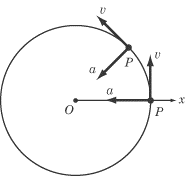Velocity and Acceleration of a Point in a Rotating Body:
The velocity and acceleration of any point P may be expressed in terms of angular velocity and angular acceleration.
Referring to Figure (a), let the position vector of the point P be r (t). As the body rotates P shall trace out a circle of radius a in a plane parallel to XOY plane, where a = r sin θ. The centre C of the circle will be along z-axis. The path of P is illustrated separately in Figure (b) for better visualization. Po is the starting point and distances s = a φ is measured from Po.
Then linear velocity of P can be obtained by
v = ds/ dt = d /dt (a φ) = a dφ/ dt = a ω

This will be directed along the tangent to the circle at P. The magnitude of velocity v is proportional to the distance of P from the centre of its path.
The acceleration of point P can be obtained as shown in Figure. We know that P moves along a circular path of radius a. the acceleration of P will have two components, viz tangential component and normal component.
Therefore, we have
a = at + an
= dv /dt t^ +( v2/a )n^
But v = a ω
∴ dv/ dt = a dω/ dt = a α
∴ a = a α t^ + (a 2 ω2 / a ) n^
∴ a = a α t^ + a ω2 n^
Magnitude

If β is the angle the resultant acceleration makes with normal component, then
tan β = at / an = α/ ω2